Assessing the Spatiotemporal Dynamics of Regional Ecosystem Health in Aydın Province, Türkiye
Abstract
1. Introduction
2. Materials and Methods
2.1. Study Area
2.2. Material
2.3. Methodological Framework
- FVC (Fractional Vegetation Coverage)
- GVMI (Global Vegetation Moisture Index)
- VTCI (Vegetation Temperature Condition Index)
- NDBSCI (Normalized Difference Build-up & Bare Soil Index)
- Heterogeneity: Shannon’s Diversity Index (SHDI), Shannon’s Evenness Index (SHEI)SHDI: Measures the compositional diversity and spatial heterogeneity of LULC, where higher values indicate richer, more varied landscape structure and greater ecological stability in landscapes.SHEI: Assesses the evenness and structural balance of LULC distribution across the landscape, where values closer to 1 indicate a more uniform and well-balanced landscape mosaic.
- Connectivity/Fragmentation: Patch Cohesion Index (COHESION), Landscape Division Index (DIVISION), Contagion (CONTAG)COHESION: Quantifies the physical and ecological connectedness of patches within each LULC class, where higher values indicate stronger habitat continuity supporting species and energy flow within landscapes.DIVISION: Measures the probability that two randomly selected pixels belong to different patches, where higher values indicate greater landscape fragmentation and spatial disruption.CONTAG: Evaluates the spatial aggregation of patch types, where higher contagion reflects dominance of large, contiguous patches and stronger landscape integrity.
- Shape/Form: Area Weighted Mean Shape Index (SHAPE_AM)SHAPE_AM: Describes the geometric complexity of patches relative to a standard shape (e.g., square), where higher values indicate larger patches with more irregular boundaries, intensifying edge effects and habitat complexity. Here, the area-weighted version is preferred as it emphasizes the contribution of dominant LULC patches, providing a more ecologically realistic representation of the landscape structure.
3. Results
3.1. LULC Change
3.2. Ecosystem Health Indices
3.3. Spatial Autocorrelation and Hotspot Analysis of REH
4. Discussion
4.1. Comparison with Similar Studies
4.2. Methodological Interpretation and Ecological Insights
4.3. Research Limitations and Future Directions
5. Conclusions
- In coastal areas, where fragmentation and ecological sensitivity are high, planning should focus on strengthening green infrastructure, habitat connectivity, and ecological zoning to mitigate vulnerability.
- In mountainous and forested regions, conservation of landscape integrity and ecosystem continuity is essential to sustain long-term resilience and ecosystem service stability.
Author Contributions
Funding
Institutional Review Board Statement
Informed Consent Statement
Data Availability Statement
Conflicts of Interest
Abbreviations
| REH | Regional Ecosystem Health |
| VOR | Vigor–Organization–Resilience |
| CVI | Comprehensive Vigor Index |
| FVC | Fractional Vegetation Coverage |
| GVMI | Global Vegetation Moisture Index |
| VTCI | Vegetation Temperature Condition Index |
| NDBSCI | Normalized Difference Build-up & Bare Soil Index |
| LC | Land Cover |
| ESA | European Space Agency |
| InVEST | Integrated Valuation of Ecosystem Services. |
References
- Lu, X.; Jiang, H.; Zhang, X.; Jin, J. Relationship between nitrogen deposition and LUCC and its impact on terrestrial ecosystem carbon budgets in China. Sci. China Earth Sci. 2016, 59, 2285–2294. [Google Scholar] [CrossRef]
- Hernández-Blanco, M.; Costanza, R.; Chen, H.; De Groot, D.; Jarvis, D.; Kubiszewski, I.; Montoya, J.; Sangha, K.; Stoeckl, N.; Turner, K.; et al. Ecosystem health, ecosystem services, and the well-being of humans and the rest of nature. Glob. Change Biol. 2022, 28, 5027–5040. [Google Scholar] [CrossRef]
- Millennium Ecosystem Assessment (MEA). Ecosystems and Human Well-Being: Synthesis; Island Press: Washington, DC, USA, 2005. [Google Scholar]
- Wu, J. Landscape sustainability science: Ecosystem services and human well-being in changing landscapes. Landsc. Ecol. 2013, 28, 999–1023. [Google Scholar] [CrossRef]
- World Health Organization (WHO). Connecting Global Priorities: Biodiversity and Human Health—A State of Knowledge Review; WHO: Geneva, Switzerland, 2015; Available online: https://apps.who.int/iris/bitstream/handle/10665/174012/9789241508537_eng.pdf (accessed on 15 February 2025).
- Corvalan, C.; Hales, S.; McMichael, A.J. Ecosystems and Human Well-being: Health Synthesis; World Health Organization: Geneva, Switzerland, 2005. [Google Scholar]
- Abraham, A.; Sommerhalder, K.; Abel, T. Landscape and well-being: A scoping study on the health-promoting impact of outdoor environments. Int. J. Public Health 2010, 55, 59–69. [Google Scholar] [CrossRef] [PubMed]
- Thompson, C.W. Linking landscape and health: The recurring theme. Landsc. Urban Plan. 2011, 99, 187–195. [Google Scholar] [CrossRef]
- Hansmann, R.; Hug, S.M.; Seeland, K. Restoration and stress relief through physical activities in forests and parks. Urban For. Urban Green. 2007, 6, 213–225. [Google Scholar] [CrossRef]
- Ward Thompson, C.; Aspinall, P.A. Natural environments and their impact on activity, health, and quality of life. Appl. Psychol. Health Well-Being 2011, 3, 230–260. [Google Scholar] [CrossRef]
- De Groot, R.S.; Wilson, M.A.; Boumans, R.M. A typology for the classification, description and valuation of ecosystem functions, goods and services. Ecol. Econ. 2002, 41, 393–408. [Google Scholar] [CrossRef]
- Nesbitt, L.; Hotte, N.; Barron, S.; Cowan, J.; Sheppard, S.R. The social and economic value of cultural ecosystem services provided by urban forests in North America. Urban For. Urban Green. 2017, 25, 103–111. [Google Scholar] [CrossRef]
- Haaland, C.; van den Bosch, C.K. Challenges and strategies for urban green-space planning in cities undergoing densification: A review. Urban For. Urban Green. 2015, 14, 760–771. [Google Scholar] [CrossRef]
- Alberti, M.; Marzluff, J.M. Ecological resilience in urban ecosystems: Linking urban patterns to human and ecological functions. Urban Ecosyst. 2004, 7, 241–265. [Google Scholar] [CrossRef]
- Goudie, A.S.; Viles, H.A. The Earth Transformed: An Introduction to Human Impacts on the Environment; John Wiley & Sons: Hoboken, NJ, USA, 2013. [Google Scholar]
- Peng, J.; Liu, Y.; Li, T.; Wu, J. Regional ecosystem health response to rural land use change: A case study in Lijiang City, China. Ecol. Indic. 2017, 72, 399–410. [Google Scholar] [CrossRef]
- Fang, Z.; Ding, T.; Chen, J.; Xue, S.; Zhou, Q.; Wang, Y.; Wang, Y.; Huang, Z.; Yang, S. Impacts of land use/land cover changes on ecosystem services in ecologically fragile regions. Sci. Total Environ. 2022, 831, 154967. [Google Scholar] [CrossRef] [PubMed]
- He, J.; Pan, Z.; Liu, D.; Guo, X. Exploring the regional differences of ecosystem health and its driving factors in China. Sci. Total Environ. 2019, 673, 553–564. [Google Scholar] [CrossRef] [PubMed]
- Lu, Y.; Wang, R.; Zhang, Y.; Su, H.; Wang, P.; Jenkins, A.; Ferrier, R.C.; Bailey, M.; Squire, G. Ecosystem health towards sustainability. Ecosyst. Health Sustain. 2015, 1, 1–15. [Google Scholar] [CrossRef]
- Das, M.; Das, A.; Pereira, P.; Mandal, A. Exploring the spatio-temporal dynamics of ecosystem health: A study on a rapidly urbanizing metropolitan area of Lower Gangetic Plain, India. Ecol. Indic. 2021, 125, 107584. [Google Scholar] [CrossRef]
- Costanza, R. Toward an operational definition of ecosystem health. In Frontiers in Ecological Economics; Edward Elgar: Cheltenham, UK, 1997; pp. 75–92. [Google Scholar]
- Peng, J.; Liu, Y.; Wu, J.; Lv, H.; Hu, X. Linking ecosystem services and landscape patterns to assess urban ecosystem health: A case study in Shenzhen City, China. Landsc. Urban Plan. 2015, 143, 56–68. [Google Scholar] [CrossRef]
- Bao, Z.; Shifaw, E.; Deng, C.; Sha, J.; Li, X.; Hanchiso, T.; Yang, W. Remote sensing-based assessment of ecosystem health by optimizing VOR model: A case study in Fuzhou City, China. Ecol. Inform. 2022, 72, 101889. [Google Scholar] [CrossRef]
- United Nations. Transforming Our World: The 2030 Agenda for Sustainable Development; United Nations: New York, NY, USA, 2015. [Google Scholar]
- IPBES (Intergovernmental Science-Policy Platform on Biodiversity and Ecosystem Services). Global Assessment Report on Biodiversity and Ecosystem Services; Díaz, S., Settele, J., Brondízio, E., Ngo, H.T., Eds.; IPBES Secretariat: Bonn, Germany, 2019. [Google Scholar]
- UNFCCC. Paris Agreement; United Nations: Paris, France, 2015; Available online: https://unfccc.int/sites/default/files/english_paris_agreement.pdf (accessed on 5 February 2024).
- Martínez-Sastre, R.; Ravera, F.; González, J.A.; Santiago, C.L.; Bidegain, I.; Munda, G. Mediterranean landscapes under change: Combining social multicriteria evaluation and the ecosystem services framework for land use planning. Land Use Policy 2017, 67, 472–486. [Google Scholar] [CrossRef]
- Nickayin, S.S.; Coluzzi, R.; Marucci, A.; Bianchini, L.; Salvati, L.; Cudlin, P.; Imbrenda, V. Desertification risk fuels spatial polarization in ‘affected’ and ‘unaffected’ landscapes in Italy. Sci. Rep. 2022, 12, 747. [Google Scholar] [CrossRef]
- Vatitsi, K.; Ioannidou, N.; Mirli, A.; Siachalou, S.; Kagalou, I.; Latinopoulos, D.; Mallinis, G. LULC change effects on environmental quality and ecosystem services using EO data in two rural river basins in Thrace, Greece. Land 2023, 12, 1140. [Google Scholar] [CrossRef]
- Kesgin Atak, B.; Ersoy Tonyaloğlu, E. Monitoring the spatiotemporal changes in regional ecosystem health: A case study in İzmir, Turkey. Environ. Monit. Assess. 2020, 192, 385. [Google Scholar] [CrossRef]
- Çobanoğlu, F.; Tunalıoğlu, R.; Tok, N. Aydın’da arkeoloji ve tarımın turizm potansiyeline katkısı. Uluslararası Kırsal Tur. Ve Kalkınma Derg. (IRTAD) 2021, 5, 2602–4462. [Google Scholar]
- Turkish State Meteorological Service (TSMS). Official Statistics. Available online: https://www.mgm.gov.tr/veridegerlendirme/il-ve-ilceler-istatistik.aspx?m=AYDIN (accessed on 15 February 2024).
- Esbah, H. Land use trends during rapid urbanization of the city of Aydın, Turkey. Environ. Manag. 2007, 39, 443–459. [Google Scholar] [CrossRef]
- Deniz, B. Kentsel Alan Kullanımlarındaki Dönüşümlerin Peyzaj Strüktür İndeksleriyle İrdelenmesi: Aydın Kenti Örneği. Ph.D. Thesis, Ege University, İzmir, Turkey, 2005. [Google Scholar]
- Tonyaloğlu, E.E.; Atak, B.K. Estimation of spatiotemporal variation in potential ecosystem services: A case study of Aydın, Turkey. In Creating Resilient Landscapes in an Era of Climate Change; Routledge: London, UK, 2022; pp. 217–230. [Google Scholar]
- Data Portal for Statistics (DPFS). Available online: https://data.tuik.gov.tr/Kategori/GetKategori?p=Nufus-ve-Demografi-109 (accessed on 5 October 2024).
- Umaç, B. Aydın İl Merkezinde Seçili Bölgelerde Biyofiziksel Ölçümlerin Karşılaştırılması. Master’s Thesis, Aydın Adnan Menderes University, Aydın, Turkey, 2019. [Google Scholar]
- THHP (Temiz Hava Hakkı Platformu). Kara Rapor 2020: Hava Kirliliği ve Sağlık Etkileri; Temiz Hava Hakkı Platformu: İstanbul, Turkey, 2020. [Google Scholar]
- Esbah, H.; Deniz, B.; Kara, B.; Atatanir, L. Monitoring urban development near a protected area. In Proceedings of the 2007 Urban Remote Sensing Joint Event, Paris, France, 11–13 April 2007; IEEE: Piscataway, NJ, USA; pp. 1–6. [Google Scholar]
- Environmental Systems Research Institute (ESRI). ArcGIS Desktop: Release 10.5.1; ESRI: Redlands, CA, USA, 2015. [Google Scholar]
- McGarigal, K.; Cushman, S.A.; Ene, E. FRAGSTATS v4: Spatial Pattern Analysis Program for Categorical Maps; University of Massachusetts: Amherst, MA, USA, 2023; Available online: https://www.fragstats.org (accessed on 10 February 2023).
- Natural Capital Project (InVEST). Integrated Valuation of Ecosystem Services (InVEST); Stanford University: Stanford, CA, USA, 2024; Available online: https://naturalcapitalproject.stanford.edu/software/invest (accessed on 8 October 2024).
- Costanza, R. Ecosystem health and ecological engineering. Ecol. Eng. 2012, 45, 24–29. [Google Scholar] [CrossRef]
- Whitford, W.G.; Rapport, D.J.; DeSoyza, A.G. Using resistance and resilience measurements for “fitness” tests in ecosystem health. J. Environ. Manag. 1999, 57, 21–29. [Google Scholar] [CrossRef]
- O’Brien, A.; Townsend, K.; Hale, R.; Sharley, D.; Pettigrove, V. How is ecosystem health defined and measured? A critical review of freshwater and estuarine studies. Ecol. Indic. 2016, 69, 722–729. [Google Scholar] [CrossRef]
- Carlson, T.N.; Ripley, D.A. On the relation between NDVI, fractional vegetation cover, and leaf area index. Remote Sens. Environ. 1997, 62, 241–252. [Google Scholar] [CrossRef]
- Ceccato, P.; Flasse, S.; Gregoire, J.M. Designing a spectral index to estimate vegetation water content from remote sensing data: Part 2. Validation and applications. Remote Sens. Environ. 2002, 82, 198–207. [Google Scholar] [CrossRef]
- Wan, Z.; Wang, P.; Li, X. Using MODIS land surface temperature and normalized difference vegetation index products for monitoring drought in the southern Great Plains, USA. Int. J. Remote Sens. 2004, 25, 61–72. [Google Scholar] [CrossRef]
- Xu, H. A new index for delineating built-up land features in satellite imagery. Int. J. Remote Sens. 2008, 29, 4269–4276. [Google Scholar] [CrossRef]
- Xu, H.; Zhang, T.; Huang, S. Quantitative comparison of Landsat 7 and ASTER multispectral measurements for the NDBI and IBI. Geogr. Res. 2013, 32, 1336–1344. [Google Scholar]
- Rikimaru, A.; Roy, P.S.; Miyatake, S. Tropical forest cover density mapping. Trop. Ecol. 2002, 43, 39–47. [Google Scholar]
- Yang, J.; Xin, Z.; Li, X.; Liang, X. Vigor–Organization–Resilience Framework for Assessing Ecosystem Health in the Qinghai–Xizang Plateau. Ecosyst. Health Sustain. 2024, 10, 260. [Google Scholar] [CrossRef]
- Chen, W.; Wang, G.; Zeng, J. Impact of Urbanization on Ecosystem Health in Chinese Urban Agglomerations. Environ. Impact Assess. Rev. 2023, 98, 106964. [Google Scholar] [CrossRef]
- Lei, D.; Zhang, Y.; Ran, Y.; Gao, L.; Li, J.; Li, Z.; Mo, J.; Liu, X. Assessment of ecosystem health based on landscape pattern in ecologically fragile regions at different spatial scales: A case study of Dianchi Lake Basin, China. Front. Environ. Sci. 2023, 11, 1076344. [Google Scholar] [CrossRef]
- Xu, W.; He, M.; Meng, W.; Zhang, Y.; Yun, H.; Lu, Y.; Huang, Z.; Mo, X.; Hu, B.; Liu, B.; et al. Temporal–spatial change of China’s coastal ecosystem health and driving factors analysis. Sci. Total Environ. 2022, 845, 157319. [Google Scholar] [CrossRef]
- Das, M.; Das, A.; Mandal, A. Research note: Ecosystem health (EH) assessment of a rapidly urbanizing metropolitan city region of eastern India—A study on Kolkata Metropolitan Area. Landsc. Urban Plan. 2020, 204, 103938. [Google Scholar] [CrossRef]
- Niquisse, S.; Cabral, P.; Rodrigues, Â.; Augusto, G. Ecosystem services and biodiversity trends in Mozambique as a consequence of land cover change. Int. J. Biodivers. Sci. Ecosyst. Serv. Manag. 2017, 13, 297–311. [Google Scholar] [CrossRef]
- Chu, L.; Sun, T.; Wang, T.; Li, Z.; Cai, C. Evolution and prediction of landscape pattern and habitat quality based on CA-Markov and InVEST model in Hubei section of Three Gorges Reservoir Area. Sustainability 2018, 10, 3854. [Google Scholar] [CrossRef]
- Wu, L.; Sun, C.; Fan, F. Estimating the characteristic spatiotemporal variation in habitat quality using the InVEST model—A case study from Guangdong–Hong Kong–Macao Greater Bay Area. Remote Sens. 2021, 13, 1008. [Google Scholar] [CrossRef]
- Natural Capital Project. InVEST 3.17.1; Stanford University; University of Minnesota; Chinese Academy of Sciences; The Nature Conservancy; World Wildlife Fund; Stockholm Resilience Centre; Royal Swedish Academy of Sciences. 2025. Available online: http://releases.naturalcapitalproject.org/invest-userguide/latest/en/index.html (accessed on 10 July 2025).
- Shi, Y.; Wang, N.; Li, T.; Wang, H.; Kang, H.; Shi, X. Evaluation of landscape ecological integrity in the Yulin region, China. Sustainability 2018, 10, 4300. [Google Scholar] [CrossRef]
- Zhao, J.; Yu, Q.; Xu, C.; Ma, J.; Liu, W.; Sun, W.; Miao, Y.; Nawaz, T. Integrated approach for ecological restoration and ecological spatial network optimization with multiple ecosystem functions in mining areas. Ecol. Indic. 2023, 156, 111141. [Google Scholar] [CrossRef]
- Folke, C.; Carpenter, S.; Walker, B.; Scheffer, M.; Elmqvist, T.; Gunderson, L.; Holling, C.S. Regime shifts, resilience, and biodiversity in ecosystem management. Annu. Rev. Ecol. Evol. Syst. 2004, 35, 557–581. [Google Scholar] [CrossRef]
- Peñuelas, J.; Sardans, J. Global change and forest disturbances in the Mediterranean Basin: Breakthroughs, knowledge gaps, and recommendations. Forests 2021, 12, 603. [Google Scholar] [CrossRef]
- Egidi, G.; Cividino, S.; Paris, E.; Palma, A.; Salvati, L.; Cudlín, P. Assessing the impact of multiple drivers of land sensitivity to desertification in a Mediterranean country. Environ. Impact Assess. Rev. 2021, 89, 106594. [Google Scholar] [CrossRef]
- Appiagyei, B.D.; Belhoucine-Guezouli, L.; Bessah, E.; Morsli, B. The changing land use and land cover in the Mediterranean Basin: Implications on forest ecosystem services. Folia Oecologica 2023, 50, 60–71. [Google Scholar] [CrossRef]
- Ruiz, I.; Sanz-Sánchez, M.J. Effects of historical land-use change in the Mediterranean environment. Sci. Total Environ. 2020, 732, 139315. [Google Scholar] [CrossRef]
- Li, Y.; Qin, L.; Wang, Y.; Liu, H.; Zhang, M.; Hao, H. Ecosystem health assessment of the largest lake wetland in the Yellow River Basin using an improved vigor-organization-resilience-services model. Ecol. Indic. 2024, 166, 112539. [Google Scholar] [CrossRef]
- Kesgin, B.; Nurlu, E. Land cover changes on the coastal zone of Çandarlı Bay, Türkiye using remotely sensed data. Environ. Monit. Assess. 2009, 157, 89–96. [Google Scholar] [CrossRef]
- Şenay, D.; Nurlu, E. Spatio-temporal assessment of landscape ecological risk using spatial statistical analysis in a basin of Türkiye. Environ. Monit. Assess. 2024, 196, 899. [Google Scholar] [CrossRef] [PubMed]
- FAO (Food and Agriculture Organization of the United Nations). The State of Food Security and Nutrition in the World 2020; FAO: Rome, Italy, 2020. [Google Scholar]
- Ersoy Tonyaloğlu, E. Future land use/land cover and its impacts on ecosystem services: Case of Aydın, Turkey. Int. J. Environ. Sci. Technol. 2025, 22, 4601–4617. [Google Scholar] [CrossRef]
- Rapport, D.J.; Costanza, R.; McMichael, A.J. Assessing ecosystem health. Trends Ecol. Evol. 1998, 13, 397–402. [Google Scholar] [CrossRef] [PubMed]
- European Commission. EU Biodiversity Strategy for 2030: Bringing Nature Back into Our Lives; Publications Office of the European Union: Luxembourg, 2020; Available online: https://environment.ec.europa.eu/strategy/biodiversity-strategy-2030_en (accessed on 15 May 2024).

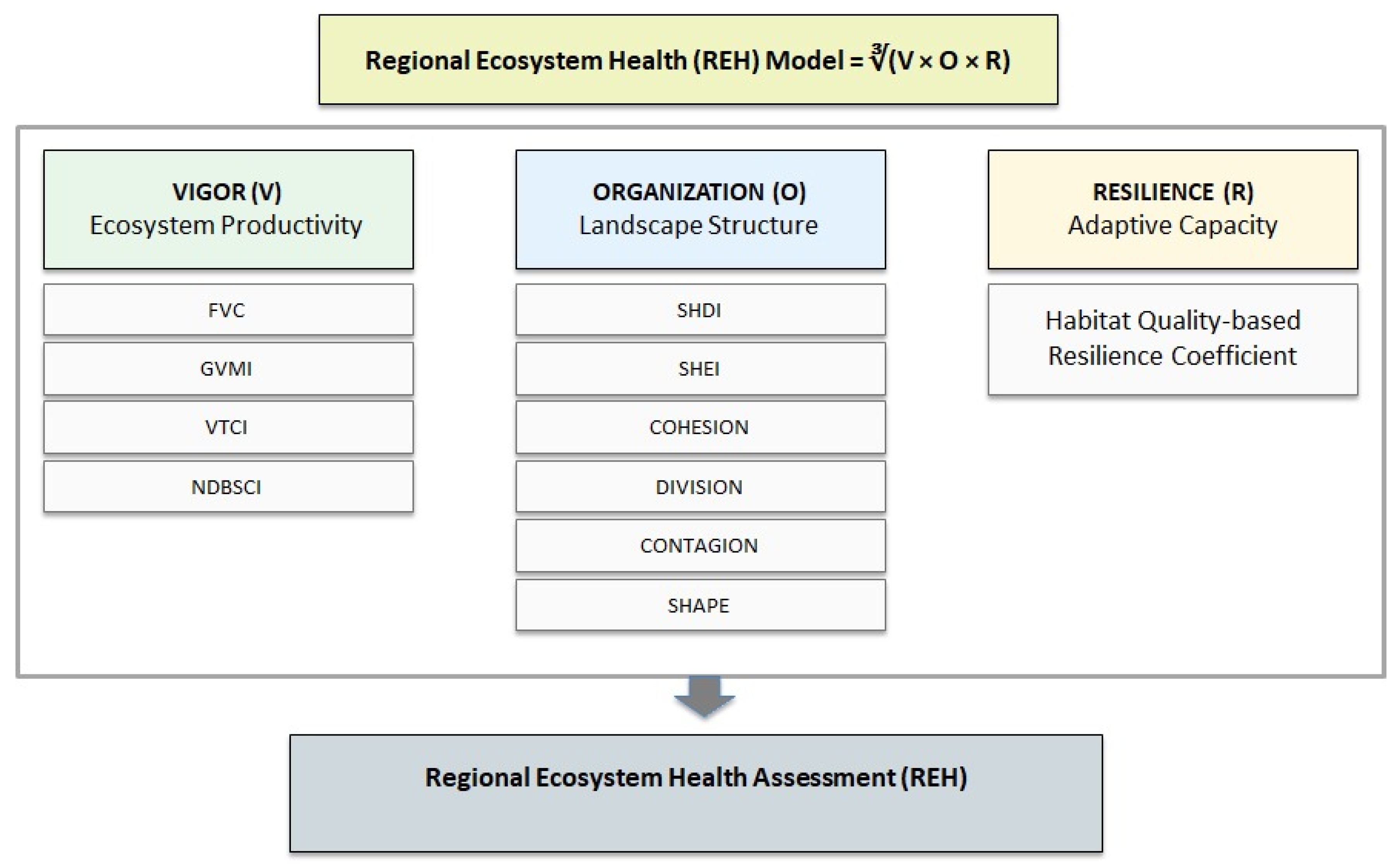
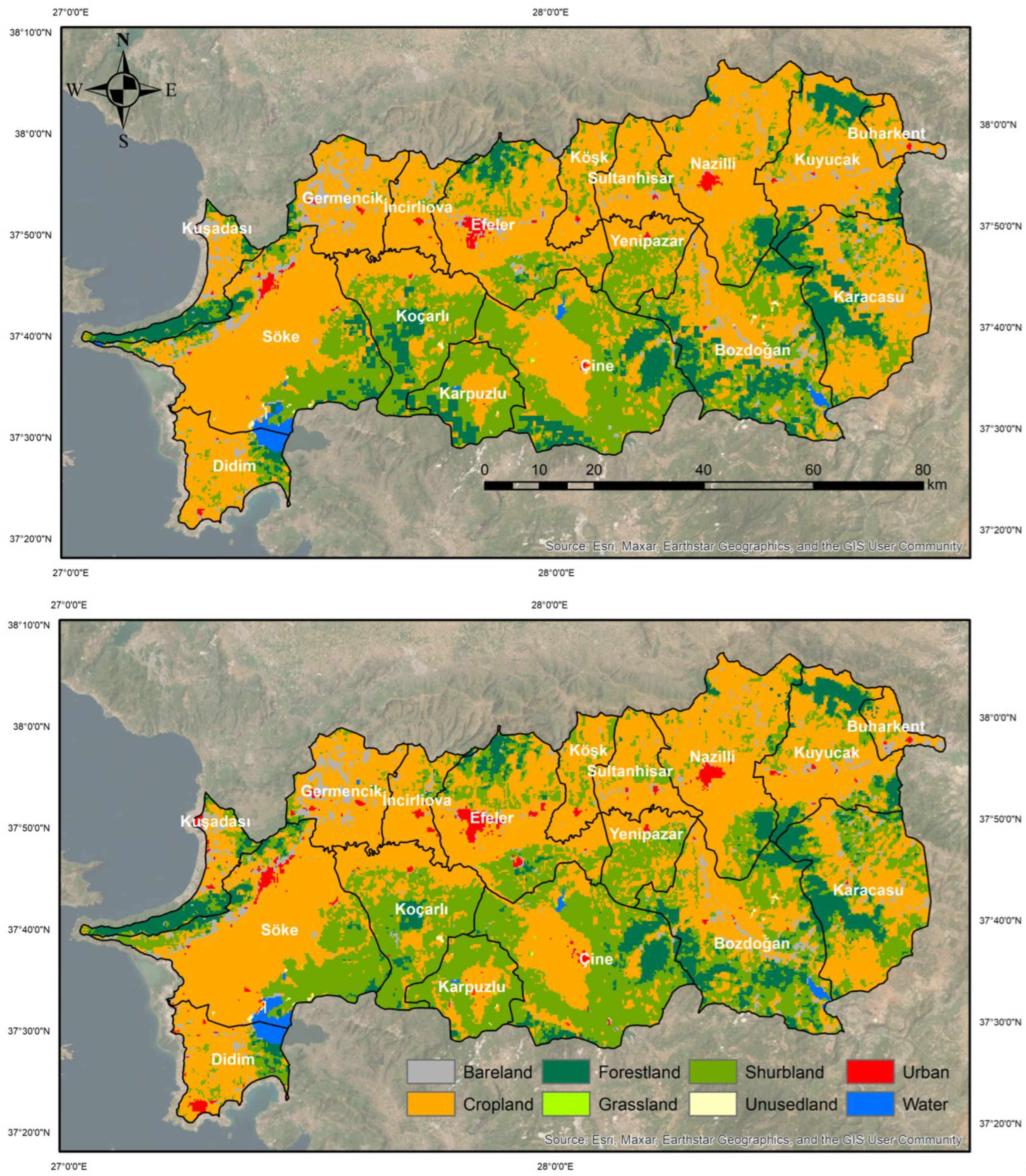
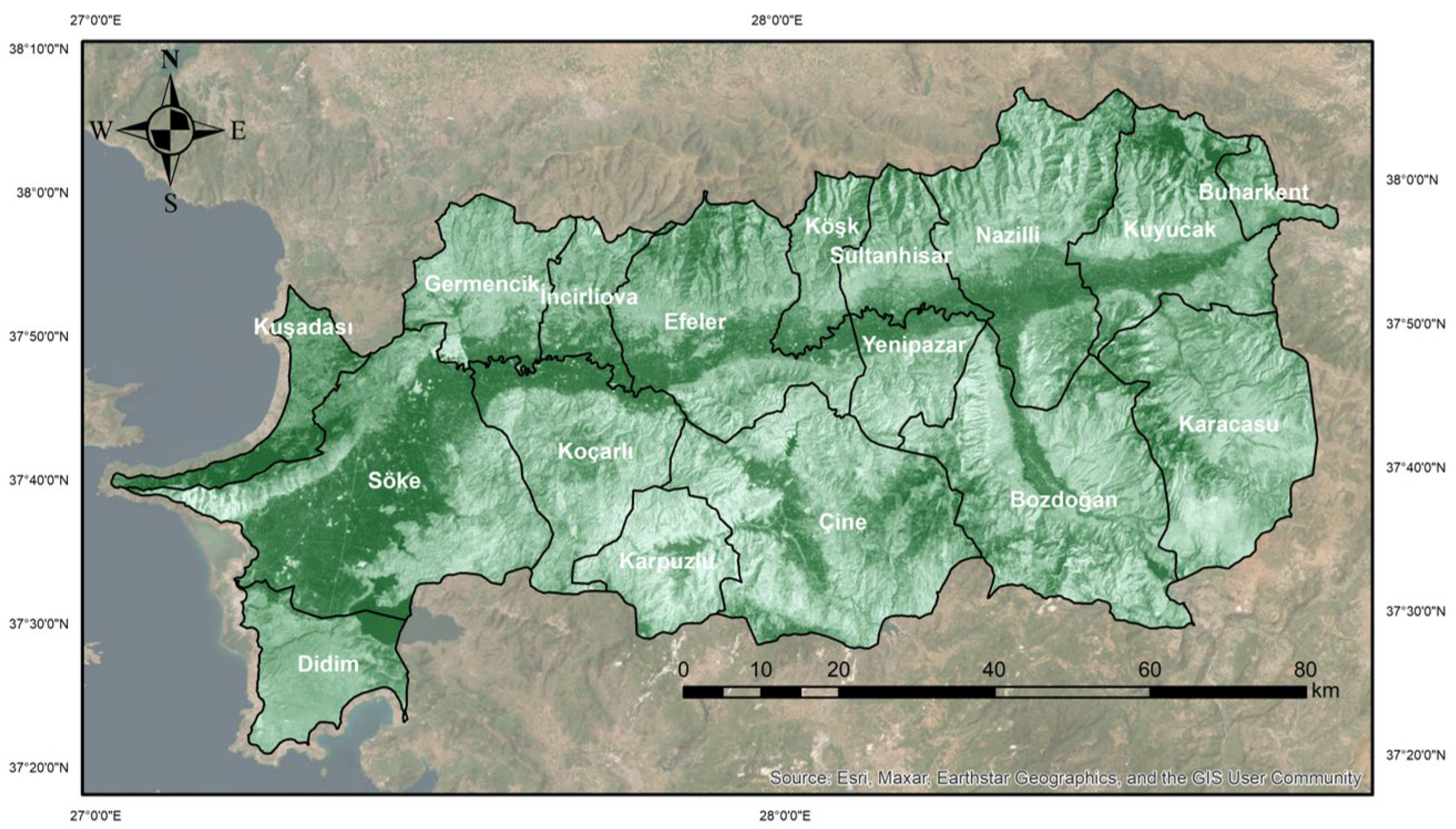
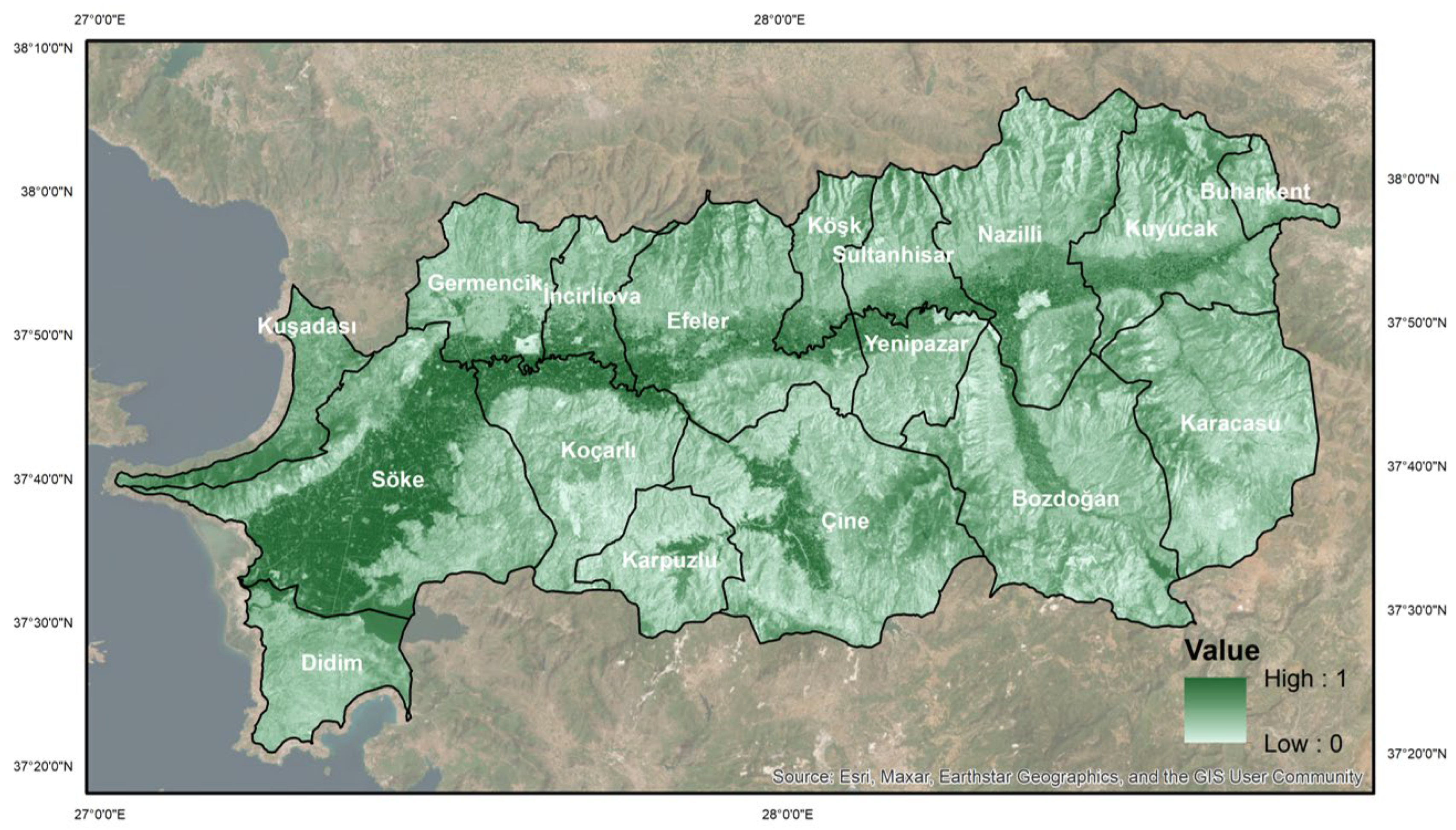
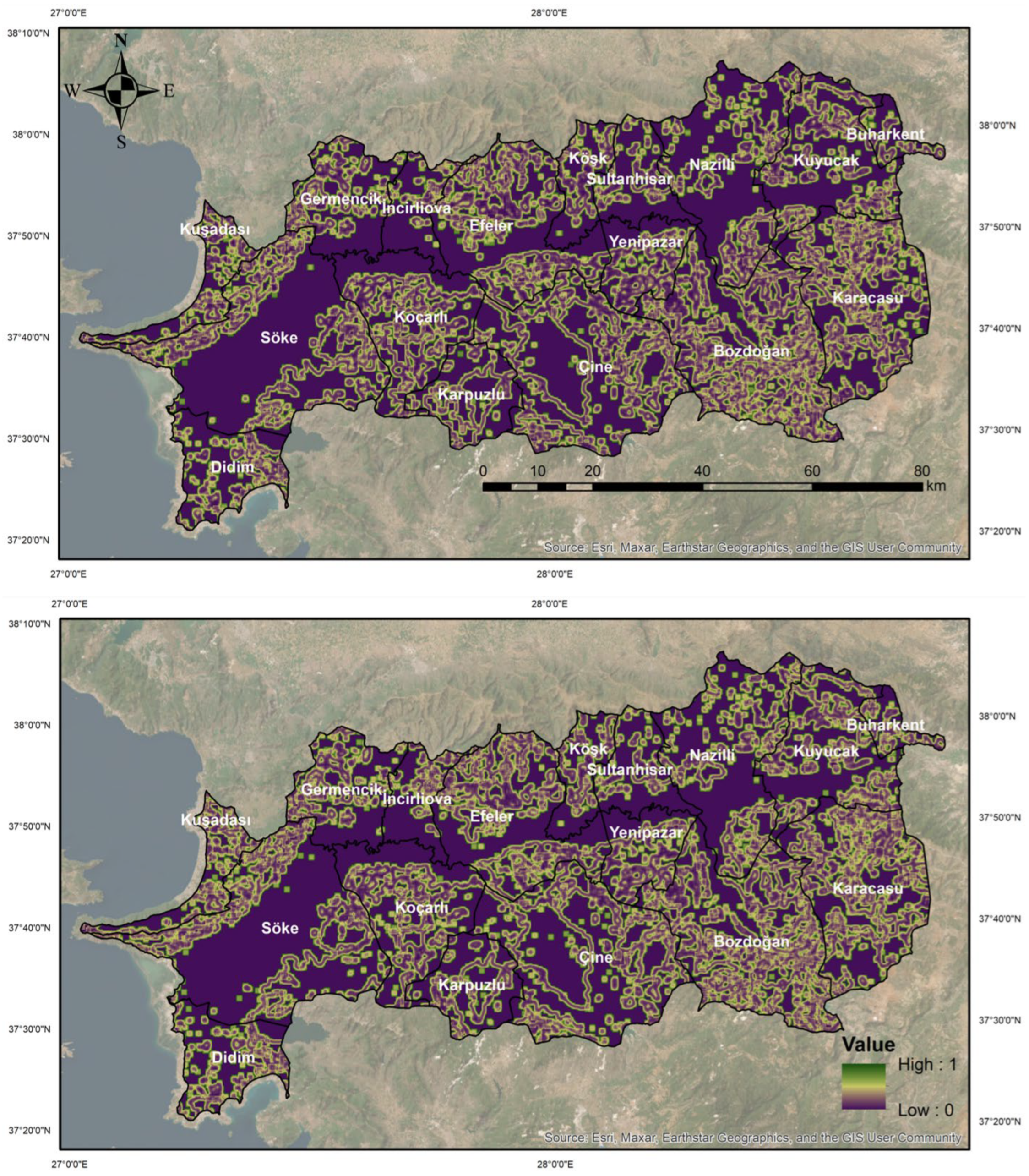


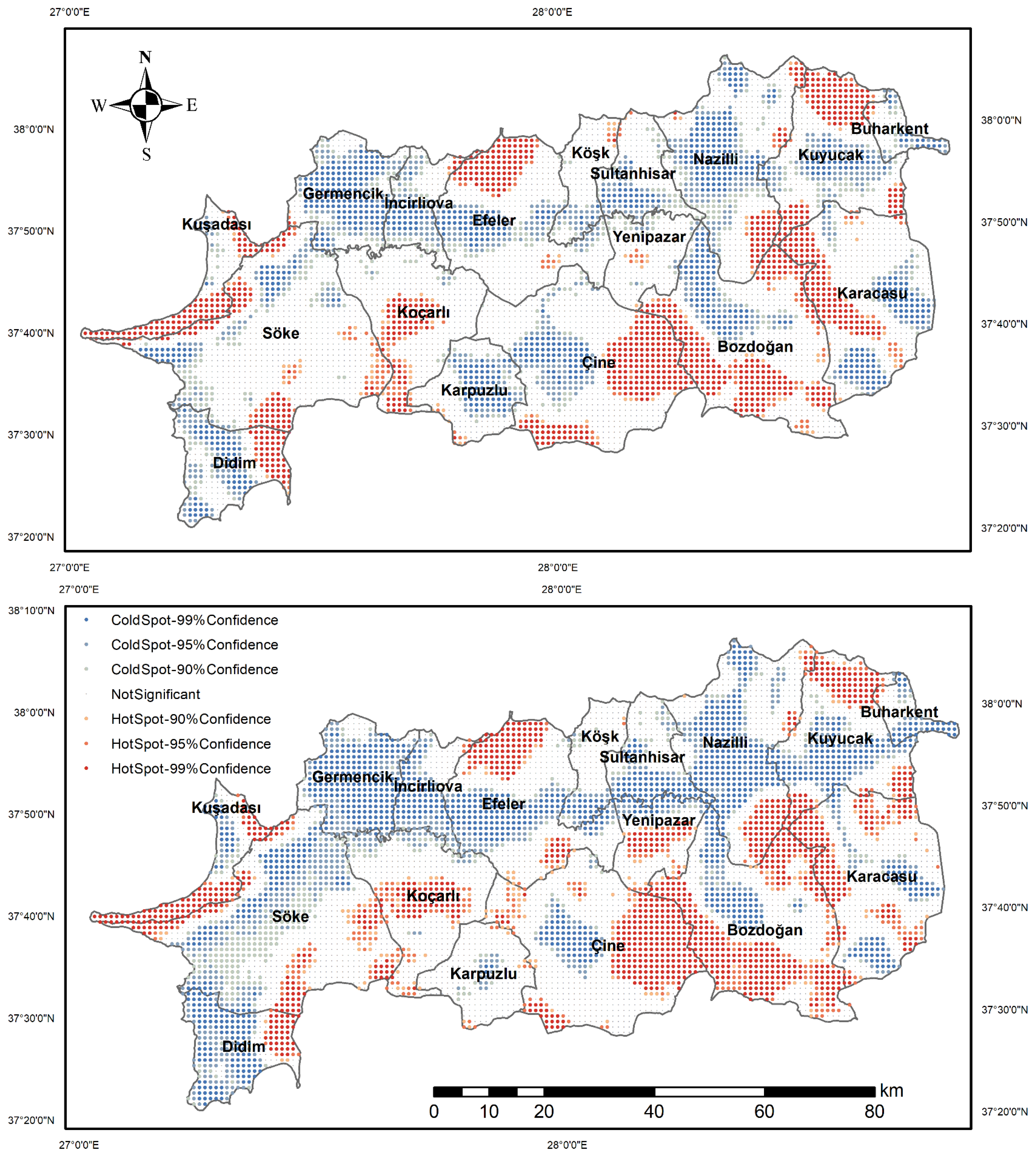
| Sensor | Acquisition Date |
|---|---|
| Landsat 5TM | 20 May 1995 |
| 11 June 1995 | |
| 29 July 1995 | |
| 14 August 1995 | |
| 15 September 1995 | |
| Landsat 8 OLI | 14 May 2020 |
| 17 July 2020 | |
| 02 August 2020 | |
| 18 August 2020 | |
| 03 September 2020 |
| Index | Formula | Source |
|---|---|---|
| Fractional Vegetation Coverage (FVC) | (NDVI − NDVImin)/(NDVImax − NDVImin) (NDVI = (NIR − R)/(NIR + R)) | Carlson, et al., 1997 [46] |
| Global Vegetation Moisture Index (GVMI) | (NIR + 0.1) − (SWIR + 0.02)/(NIR + 0.1) + (SWIR + 0.02) | Ceccato et al., 2002 [47] |
| Vegetation Temperature Condition Index (VTCI) | (LSTNDVImaxi − LSTNDVIi)/(LSTNDVImaxi − LSTNDVIi) | Wan et al., 2004 [48] |
| Normalized Differential Build-Up and Bare Soil Index (NDBSCI) | (IBI + SI)/2 | Xu 2008 [49] |
| The Index-based Built-up Index (IBI) | (2MIR/(MIR + NIR) − (NIR/(NIR + Red) + Green (Green + MIR))/2MIR/(MIR +NIR) + (NIR/(NIR + Red) + Green ((Green + MIR)) | Xu 2013 [50] |
| The Soil Index (SI) | ((MIR + Red) − (NIR + Blue))/((MIR + Red) + (NIR + Blue)) | Rikimaru et al., 2002 [51] |
| 1995 (ha) | ||||||||||
|---|---|---|---|---|---|---|---|---|---|---|
| C | F | S | G | UL | U | B | W | Class Total | ||
| 2020 (ha) | C | 366,307.02 | 7354.44 | 16,461.09 | 145.62 | 151.02 | 448.38 | 5681.52 | 167.85 | 396,716.94 |
| F | 4860.36 | 51,706.98 | 6690.42 | 0 | 0 | 0 | 138.42 | 70.83 | 63,467.01 | |
| S | 38,693.88 | 15,225.57 | 168,082.65 | 25.47 | 118.26 | 7.38 | 1523.61 | 193.5 | 223,870.32 | |
| G | 62.1 | 0 | 38.79 | 126.09 | 6.93 | 0 | 0 | 18.45 | 252.36 | |
| UL | 119.25 | 0 | 140.49 | 0 | 489.42 | 0 | 25,816.77 | 22.14 | 788.4 | |
| U | 3335.13 | 115.56 | 138.51 | 0 | 39.42 | 4481.82 | 2152.89 | 0 | 10,263.33 | |
| B | 5507.73 | 611.55 | 1151.1 | 0 | 15.75 | 180.18 | 16,255.08 | 68.22 | 23,789.61 | |
| W | 203.31 | 189.54 | 188.37 | 3.51 | 24.21 | 0 | 48.15 | 4222.98 | 4880.07 | |
| Change (%) | −5.34 | −15.61 | 16.06 | −16.07 | −6.70 | 100.54 | −7.85 | 2.44 | ||
| Class Total | 419,088.78 | 75,203.64 | 192,891.42 | 300.69 | 845.01 | 5117.76 | 25,816.77 | 4763.97 | ||
| Vigor (V-CVI) | Resilience (R) | Organization (O) | Regional Ecosystem Health (REH) | ||||||
|---|---|---|---|---|---|---|---|---|---|
| Mean | Std | Mean | Std | Mean | Std | Mean | Std | ||
| Cropland | 1995 | 0.466 | 0.183 | 0.385 | 0.093 | 0.337 | 0.344 | 0.107 | 0.051 |
| 2020 | 0.552 | 0.164 | 0.384 | 0.123 | 0.340 | 0.341 | 0.144 | 0.067 | |
| Forestland | 1995 | 0.545 | 0.189 | 0.913 | 0.133 | 0.482 | 0.288 | 0.354 | 0.161 |
| 2020 | 0.591 | 0.105 | 0.880 | 0.152 | 0.464 | 0.292 | 0.412 | 0.149 | |
| Shrubland | 1995 | 0.367 | 0.141 | 0.821 | 0.138 | 0.470 | 0.273 | 0.215 | 0.107 |
| 2020 | 0.470 | 0.090 | 0.778 | 0.172 | 0.462 | 0.287 | 0.291 | 0.118 | |
| Grassland | 1995 | 0.340 | 0.166 | 0.622 | 0.133 | 0.532 | 0.062 | 0.160 | 0.088 |
| 2020 | 0.445 | 0.128 | 0.604 | 0.188 | 0.523 | 0.070 | 0.230 | 0.105 | |
| Unusedland | 1995 | 0.396 | 0.197 | 0.637 | 0.191 | 0.519 | 0.075 | 0.194 | 0.129 |
| 2020 | 0.513 | 0.117 | 0.588 | 0.219 | 0.517 | 0.070 | 0.248 | 0.105 | |
| Urban | 1995 | 0.432 | 0.079 | 0.017 | 0.066 | 0.529 | 0.219 | 0.006 | 0.024 |
| 2020 | 0.551 | 0.083 | 0.053 | 0.114 | 0.502 | 0.237 | 0.025 | 0.055 | |
| Bareland | 1995 | 0.371 | 0.114 | 0.082 | 0.186 | 0.512 | 0.096 | 0.022 | 0.054 |
| 2020 | 0.476 | 0.093 | 0.147 | 0.231 | 0.514 | 0.093 | 0.058 | 0.093 | |
| Water | 1995 | 0.729 | 0.158 | 0.925 | 0.105 | 0.364 | 0.334 | 0.427 | 0.165 |
| 2020 | 0.734 | 0.098 | 0.788 | 0.176 | 0.366 | 0.339 | 0.411 | 0.160 | |
| Vigor (V-CVI) | Resilience (R) | Organization (O) | Regional Ecosystem Health (REH) | ||||||
|---|---|---|---|---|---|---|---|---|---|
| Mean | Std | Mean | Std | Mean | Std | Mean | Std | ||
| Buharkent | 1995 | 0.46 | 0.12 | 0.36 | 0.2 | 0.42 | 0.33 | 0.12 | 0.11 |
| 2020 | 0.5 | 0.1 | 0.37 | 0.22 | 0.47 | 0.29 | 0.15 | 0.12 | |
| Sultanhisar | 1995 | 0.47 | 0.15 | 0.41 | 0.16 | 0.32 | 0.34 | 0.12 | 0.08 |
| 2020 | 0.54 | 0.13 | 0.41 | 0.16 | 0.32 | 0.34 | 0.15 | 0.09 | |
| Köşk | 1995 | 0.48 | 0.15 | 0.46 | 0.19 | 0.39 | 0.32 | 0.15 | 0.1 |
| 2020 | 0.56 | 0.12 | 0.46 | 0.19 | 0.39 | 0.32 | 0.19 | 0.12 | |
| Kuyucak | 1995 | 0.49 | 0.18 | 0.5 | 0.26 | 0.4 | 0.33 | 0.17 | 0.15 |
| 2020 | 0.53 | 0.12 | 0.52 | 0.27 | 0.41 | 0.32 | 0.21 | 0.15 | |
| Germencik | 1995 | 0.41 | 0.14 | 0.33 | 0.16 | 0.39 | 0.33 | 0.09 | 0.07 |
| 2020 | 0.51 | 0.13 | 0.31 | 0.16 | 0.4 | 0.32 | 0.12 | 0.08 | |
| Kuşadası | 1995 | 0.66 | 0.15 | 0.56 | 0.31 | 0.49 | 0.28 | 0.28 | 0.2 |
| 2020 | 0.63 | 0.09 | 0.56 | 0.31 | 0.5 | 0.27 | 0.29 | 0.19 | |
| İncirliova | 1995 | 0.5 | 0.15 | 0.39 | 0.15 | 0.28 | 0.34 | 0.11 | 0.08 |
| 2020 | 0.58 | 0.14 | 0.39 | 0.17 | 0.31 | 0.33 | 0.15 | 0.09 | |
| Nazilli | 1995 | 0.46 | 0.17 | 0.45 | 0.21 | 0.33 | 0.34 | 0.13 | 0.11 |
| 2020 | 0.52 | 0.13 | 0.46 | 0.22 | 0.36 | 0.34 | 0.18 | 0.13 | |
| Efeler | 1995 | 0.48 | 0.16 | 0.49 | 0.26 | 0.43 | 0.31 | 0.16 | 0.13 |
| 2020 | 0.54 | 0.13 | 0.49 | 0.26 | 0.42 | 0.31 | 0.2 | 0.14 | |
| Yenipazar | 1995 | 0.41 | 0.17 | 0.6 | 0.24 | 0.41 | 0.3 | 0.15 | 0.08 |
| 2020 | 0.5 | 0.13 | 0.6 | 0.25 | 0.42 | 0.3 | 0.22 | 0.12 | |
| Karacasu | 1995 | 0.39 | 0.14 | 0.56 | 0.27 | 0.47 | 0.29 | 0.17 | 0.13 |
| 2020 | 0.47 | 0.1 | 0.59 | 0.26 | 0.47 | 0.28 | 0.23 | 0.14 | |
| Koçarlı | 1995 | 0.42 | 0.18 | 0.66 | 0.25 | 0.4 | 0.31 | 0.17 | 0.1 |
| 2020 | 0.51 | 0.16 | 0.64 | 0.24 | 0.382 | 0.321 | 0.227 | 0.115 | |
| Söke | 1995 | 0.56 | 0.2 | 0.5 | 0.25 | 0.288 | 0.325 | 0.152 | 0.102 |
| 2020 | 0.65 | 0.18 | 0.49 | 0.25 | 0.278 | 0.325 | 0.196 | 0.114 | |
| Bozdoğan | 1995 | 0.39 | 0.16 | 0.63 | 0.29 | 0.511 | 0.245 | 0.191 | 0.14 |
| 2020 | 0.49 | 0.11 | 0.63 | 0.29 | 0.501 | 0.254 | 0.257 | 0.156 | |
| Karpuzlu | 1995 | 0.261 | 0.128 | 0.756 | 0.226 | 0.392 | 0.336 | 0.126 | 0.084 |
| 2020 | 0.429 | 0.104 | 0.68 | 0.227 | 0.373 | 0.338 | 0.203 | 0.094 | |
| Çine | 1995 | 0.379 | 0.166 | 0.719 | 0.259 | 0.394 | 0.328 | 0.182 | 0.132 |
| 2020 | 0.492 | 0.131 | 0.694 | 0.252 | 0.387 | 0.333 | 0.251 | 0.145 | |
| Didim | 1995 | 0.439 | 0.136 | 0.469 | 0.236 | 0.407 | 0.335 | 0.147 | 0.119 |
| 2020 | 0.515 | 0.109 | 0.422 | 0.222 | 0.435 | 0.326 | 0.171 | 0.119 | |
Disclaimer/Publisher’s Note: The statements, opinions and data contained in all publications are solely those of the individual author(s) and contributor(s) and not of MDPI and/or the editor(s). MDPI and/or the editor(s) disclaim responsibility for any injury to people or property resulting from any ideas, methods, instructions or products referred to in the content. |
© 2025 by the authors. Licensee MDPI, Basel, Switzerland. This article is an open access article distributed under the terms and conditions of the Creative Commons Attribution (CC BY) license (https://creativecommons.org/licenses/by/4.0/).
Share and Cite
Kesgin Atak, B.; Tonyaloğlu, E.E. Assessing the Spatiotemporal Dynamics of Regional Ecosystem Health in Aydın Province, Türkiye. Sustainability 2025, 17, 10522. https://doi.org/10.3390/su172310522
Kesgin Atak B, Tonyaloğlu EE. Assessing the Spatiotemporal Dynamics of Regional Ecosystem Health in Aydın Province, Türkiye. Sustainability. 2025; 17(23):10522. https://doi.org/10.3390/su172310522
Chicago/Turabian StyleKesgin Atak, Birsen, and Ebru Ersoy Tonyaloğlu. 2025. "Assessing the Spatiotemporal Dynamics of Regional Ecosystem Health in Aydın Province, Türkiye" Sustainability 17, no. 23: 10522. https://doi.org/10.3390/su172310522
APA StyleKesgin Atak, B., & Tonyaloğlu, E. E. (2025). Assessing the Spatiotemporal Dynamics of Regional Ecosystem Health in Aydın Province, Türkiye. Sustainability, 17(23), 10522. https://doi.org/10.3390/su172310522







